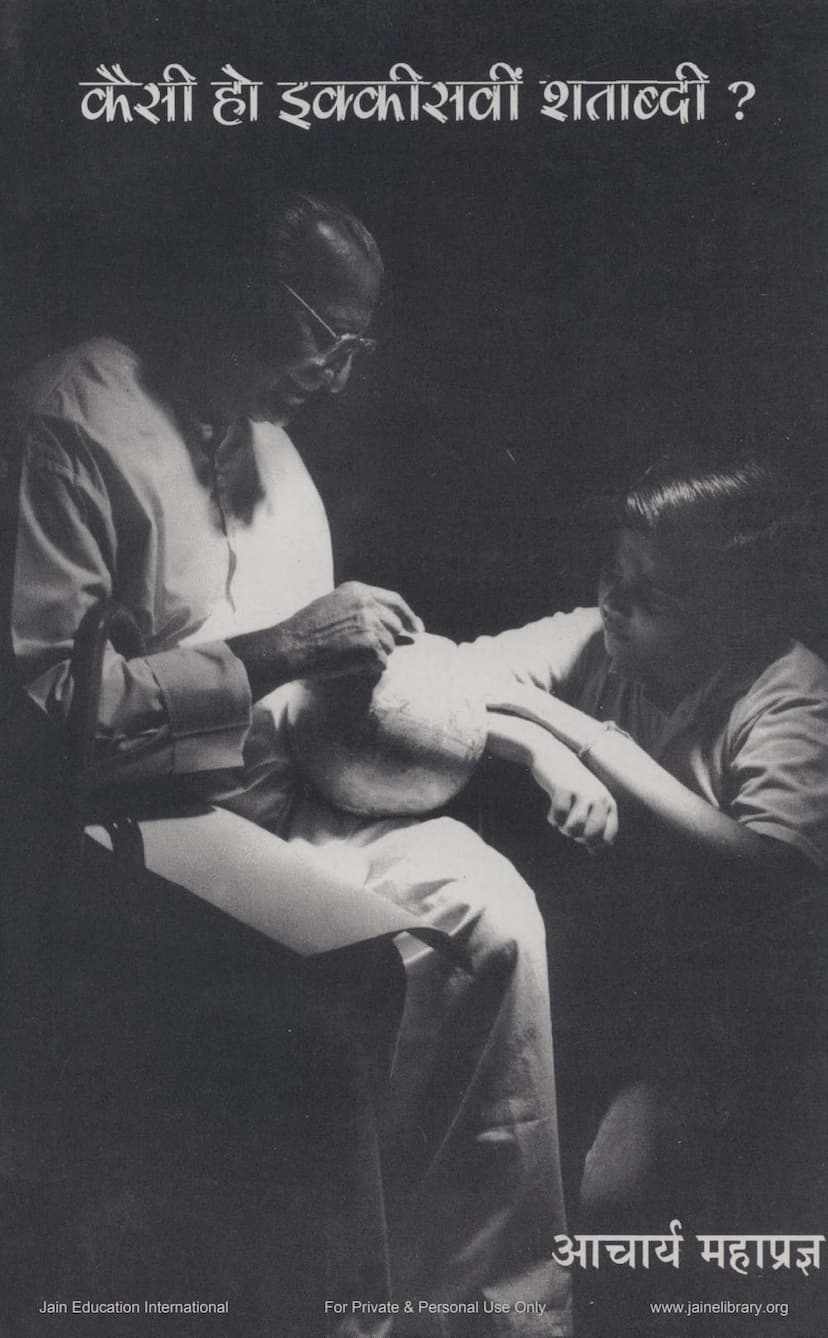Kaisi Ho Ekkisvi Sadi
Added to library: September 2, 2025

Summary
This comprehensive summary of "Kaisi ho Ekkisvi Sadi" (How should the 21st Century be?) by Acharya Mahapragna, published by Jain Vishva Bharati, delves into the critical questions facing humanity at the dawn of the 21st century. The book acts as a philosophical guide, urging a transition from the materialistic and often violent trajectory of the 20th century towards a more spiritually and ethically grounded future.
The Core Question:
The central theme revolves around the aspiration for the 21st century to be an era of spirituality, non-violence (Ahimsa), mental peace, universal friendship, and global harmony. It questions whether humanity will merely repeat the patterns of the past or usher in a new era where values are prioritized over material possessions.
Critique of the 20th Century and its Legacy:
The book offers a sharp critique of the 20th century, acknowledging its immense scientific and technological progress, which has shrunk distances and connected the world. However, it also highlights the significant negative consequences:
- Division and Conflict: The 20th century is noted for exacerbating divisions based on religion, caste, and ideology, leading to unprecedented violence and the development of mass-destruction weapons.
- Materialism and Ethical Decline: A dominant materialistic and consumerist outlook, driven by the pursuit of comfort and convenience, has led to a decline in moral values. This is seen as the root cause of many societal ills.
- Environmental Degradation: The unchecked pursuit of economic growth has resulted in severe environmental pollution and ecological imbalance.
- Focus on External Development: The emphasis has been on external development (technology, industry) without a corresponding development of internal consciousness and ethical values.
The Central Problem: The Crisis of Moral Values:
Acharya Mahapragna identifies a deep crisis of moral values as the most critical issue. He questions who is responsible for addressing this crisis when political leaders focus on elections, industrialists on their businesses, and even religious leaders on expanding their influence. He laments the lack of serious contemplation on the root causes of this decline.
Root Causes and the Nature of Greed:
The book argues that the problem lies not just in the methods but in the fundamental goal of humanity: maximum consumption, maximum convenience, and maximum wealth. This inherent flaw, the author contends, fuels both lawful accumulation and criminal activity, blurring the lines between the honest and the dishonest. Greed (Parigraha) is identified as the primary flaw, with "desire" (Kama) being a derivative. The author contrasts psychological theories with Jain philosophy, emphasizing that greed, not just sexual desire, is the root of many negative tendencies.
The Path to a Better Future: Ethical Foundation and Consciousness:
The book strongly advocates for a paradigm shift centered on:
- Ethical Imperative: Scientific progress, democracy, and economic development can only be beneficial if grounded in strong ethical values. Without them, these advancements become detrimental to human existence.
- Consciousness Development: The true path forward lies in developing "atindriya chetna" (transcendent consciousness), which means going beyond sensory and mental awareness to understand oneself, society, and the world. This is not about supernatural powers but about a deeper, holistic perception.
- Harmony of Inner and Outer: The author stresses the need for a balanced approach that integrates both material development and spiritual/ethical growth. Neither alone is sufficient.
- The Role of Religion and Ethics: Religion is presented not as dogma but as a guide for purifying desires (Kama) and wealth (Artha). The focus should be on "Kama shuddhi" (purification of desire) and "Artha shuddhi" (purification of wealth) through spiritual practices.
Key Concepts and Solutions Proposed:
- Anekantavada (Non-absolutism): The Jain principle of anekantavada is highlighted as a crucial tool for understanding different perspectives and fostering harmony, moving beyond rigid, one-sided viewpoints.
- Samayik (Balance): The need for balance in all aspects of life – economic development with ethical restraint, intellectual development with emotional maturity, and individual needs with societal responsibilities.
- Manushya ka Pariskar (Human Refinement): The core of the solution lies in the refinement of human desires, attitudes, and consciousness.
- Need for Inner Transformation: External regulations and laws are insufficient. The true change must come from within, through the transformation of consciousness and attitudes.
- The Importance of "Vidya" (Knowledge/Discipline): The book emphasizes "Jeevan Vigyan" (Life Science) as a system of practices involving breath control, sensory discipline, and ethical cultivation, aimed at transforming consciousness and behavior.
- Ahimsa (Non-violence): Ahimsa is presented not just as the absence of physical violence but as a broader principle encompassing respect for all life, including plants, and a rejection of exploitation. It is intrinsically linked to environmental protection and the cultivation of compassion.
- Aparigraha (Non-possession/Limited Desire): The concept of limiting desires and possessions is crucial for achieving inner peace and societal harmony, directly addressing the root of environmental degradation and social conflict.
- The "Third Option": The book suggests moving beyond the dichotomy of poverty and wealth, proposing a "third option" that combines the satisfaction of basic needs with the detachment from material possessions and desires.
- Responsible Development: Development must be balanced and ethical, respecting ecological limits and the well-being of all sentient beings. Unfettered pursuit of economic growth, driven by greed, is unsustainable and destructive.
- Education for Holistic Development: Education must shift from purely intellectual and vocational training to encompass the development of emotional intelligence, ethical values, and a sense of responsibility towards oneself, society, and the environment.
Call to Action:
The book concludes with a powerful call to action, urging individuals and society to embrace these principles and work towards creating a 21st century that is truly characterized by peace, harmony, and spiritual progress. It emphasizes that the responsibility for change lies with each individual and collective effort is essential.